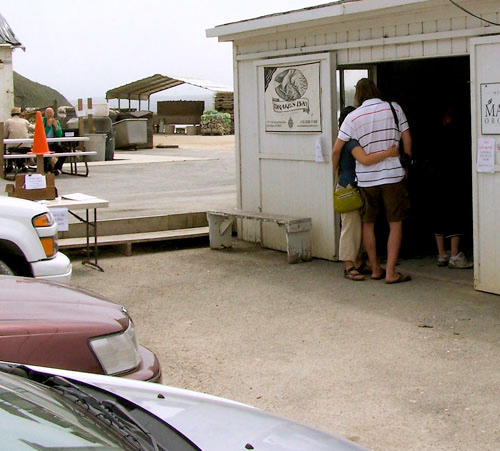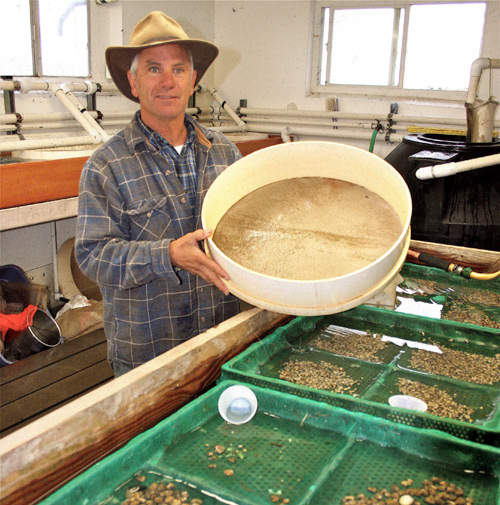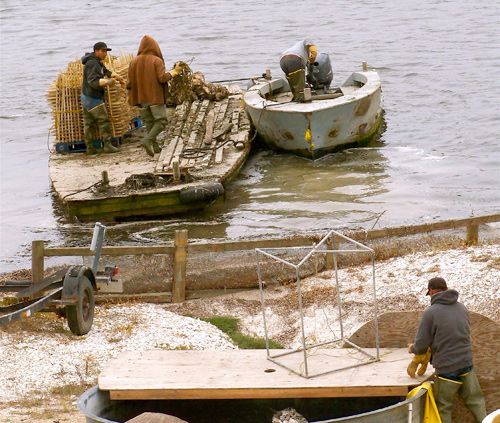Guest blog from David Mitchell, of "Sparsely, Sage and Timely" in west Marin, California
He left with the understanding he would receive only three minutes to present his case for continuing to do business in the Point Reyes National Seashore after his present permit expires Nov. 30. When he got to the NAS meeting, however, Lunny received about half an hour to answer questions.

Drakes Bay Oyster Company owner Kevin Lunny.
This wasn’t supposed to be happening. Lunny bought the business from its former owner, Tom Johnson, seven years ago. At that time, Lunny and his lawyer negotiated a “statement of principle” with Interior Department attorneys and Jon Jarvis, then Pacific West Regional Director of the Park Service.
The agreement signed by both Jarvis and Lunny guaranteed the oyster grower that he would have plenty of input if an environmental-impact statement were required when the permit was up for renewal. Nonetheless, when the Park Service began preparing an EIS a year and a half ago, Lunny found himself excluded from the scoping process.
He brought up the legal document he and Jarvis (now national director of the Park Service) had signed only to have the Park Service tell him it was “unenforceable,” he noted this week. “If you don’t like it,” the Park Service added, “take it to court.” It was not the first time the Park Service had used that tactic.
Six years ago, former National Seashore Supt. Don Neubacher began a campaign of falsehoods — later exposed by the Inspector General of the Interior Department, among others — regarding the oyster operation in an effort to create opposition to renewing its permit. Lunny at the time reported that when he objected to the way he was being treated by the park, Neubacher’s response was, “You’ve got to remember, I don’t have to pay my lawyers.”

Retail sales building at Drakes Bay Oyster Company.
Neubacher’s political reason — aside from what turned into personal antipathy — for wanting Lunny to shut down operations in Drakes Estero is that Congress in 1976 had declared the surrounding area “potential wilderness.” The park, however, has chosen to ignore the congressional testimony of the legislation’s sponsors who said the proposed potential-wilderness designation would not affect oyster growing in the estero.
Although the Park Service has made no secret of being ready to ruin Lunny with legal bills if he stands on his rights, the stratagem hasn’t worked so far. Already, he has received “over $1 million worth of pro bono legal help” from one law firm, and two others are also joining in, Lunny said.
“The San Francisco Bay Area,” the oysterman explained, is “a tight-knit community, and people have been good to us. All are liberal Democrats, green-minded people, non-corporate. They care about honesty in government.” The unpaid legal representation could prove invaluable to Lunny should he need to legally challenge an adverse decision by the Park Service on his permit.
The Park Service has put forth various claims — each debunked in succession — that oyster growing in the estuary is bad for the environment. In contrast, an earlier National Academy of Sciences review found that oyster cultivation is not causing significant environmental problems and may well be benefiting the estero’s ecosystem.
The estuary used to be rich in native, Olympia oysters, but they were harvested to virtual extinction by the 1950s and 60s. The former oyster-company owners, the Johnson family, then began raising Pacific oysters, which have restored the ecosystem, the first Academy of Sciences review noted. Oysters are filter feeders that clean the water.
The Park Service in response has claimed there never were native oysters in the estero despite millions of Olympia oyster shells found in the middens (shell heaps) of Native Americans who lived beside the estuary.
Carbon dating has now determined the shells in the middens are prehistoric, prompting the Park Service to claim — without evidence — that Native Americans must have caught these millions of oysters in Tomales Bay and for unknown reasons hauled them all the way to Drakes Bay to eat them. To Lunny, the scenario seems ridiculous.
Larvae for today’s Pacific oysters, which are the variety grown on the West Coast, come from “carefully controlled” hatcheries in Oregon and Washington, Lunny said.
 Growing oyster larvae into seed oysters (Photo by Janine Warner).
Growing oyster larvae into seed oysters (Photo by Janine Warner).
He raises the larvae in tanks until they are large enough to attach themselves to old shells and then start growing their own shells. Only when these “seed oysters” are large enough not to fall through mesh growing bags are they hung from racks in the estero. In other cases, shells holding the seed oysters are hung in a line from the racks.
In response to EIR-related questions from the Park Service, Lunny on July 5 wrote to National Seashore Supt. Cecily Muldoon:
“Approximately 40 percent of Drakes Bay Oyster Company income is from onsite retail sales, 40 percent is sold directly to local markets and restaurants — all delivered by DBOC directly, 18 percent is sold to Tomales Bay shellfish growers, and 2 percent is sold through a wholesale seafood distributor based in San Francisco.”
 Oysters from racks in Drakes Estero are unloaded from a barge at the oyster company’s onshore site.
Oysters from racks in Drakes Estero are unloaded from a barge at the oyster company’s onshore site.
In a very good year, DBOC might produce 850,000 pounds of oysters, Lunny wrote. Those numbers would suggest that if the full 18 percent of DBOC’s total production in a very good year were to go to to Hog Island and Tomales Bay oyster companies, the total would be a whopping 153,000 pounds.
“The Tomales Bay growers have a huge demand they can’t meet,” Lunny said Monday. If Drakes Bay Oyster Company were shut down by the park, the effect on Tomales Bay growers would be significant, and those growers have supported DBOC’s efforts to renew its permit.
“We like to work with neighbors and colleagues,” Lunny said, and want the oysters sold locally to “come from locals.”

Washing freshly harvested oysters.
Nor is there any opportunity for Drakes Bay Oyster Company to relocate to Tomales Bay.
In his July 5 letter to Seashore Supt. Muldoon, Lunny wrote: “It is important to note that in late 2008 through early 2009, the National Park Service (NPS) seriously misled the public by telling US Senator Dianne Feinstein, the DBOC, and the public that NPS had a plan and an offer to relocate DBOC to Tomales Bay.
“In fact, NPS did not consult with the California Department of Fish and Game (CDFG) prior to making this assertion and did not have a plan to relocate DBOC.
“After NPS made the claim that it had a plan to relocate DBOC to Tomales Bay, NPS was informed by CDFG that this relocation was impossible for several reasons:
• “NPS has no authority over the Fish and Game Commission (FGC) and CDFG leases and has no say over how shellfish leases are issued by the FGC.
• “Tomales Bay shellfish production is already maximized to the extent practicable.
• “There were no available leases in Tomales Bay to relocate DBOC.
“DBOC, in good faith, participated in discussions, committed to negotiations, and was willing to evaluate a proposal. It was only later that it became clear that the NPS did not have a relocation plan or proposal when it told Senator Feinstein and DBOC that it did. The NPS promised a relocation that was impossible.
“Nevertheless, the public remains misinformed about this relocation proposal. Members of the public known to be working closely with NPS staff continuously criticize DBOC for failing to negotiate with NPS regarding relocation.
“NPS has certainly heard these misrepresentations from the NPS supporters yet NPS has failed to correct the public record.”
A check on Tuesday with Kirsten Ramey, who is in charge of marine aquaculture for Fish and Game, found that while it technically might be possible to get a new shellfish-growing lease in Tomales Bay, in practical terms, it could not be done. The permits and studies necessary would be overwhelming.
Among the agencies that would have to study the proposal and approve it, she said, would be state Fish and Game, the County of Marin, the California Coastal Commission, the Regional Water Quality Control Board, the Army Corps of Engineers, the Coast Guard and possibly others. Virtually no one can afford the cost, which is why no new leases have been issued for years, she explained.
Lunny had not received a response to his letter to Supt. Muldoon before his trip to Irvine Tuesday, but DBOC critic Gordon Bennett had read it thanks to the park’s having quietly posted the letter online.
Ramey noted that Bennett — citing the letter — had called her asking about oysters from Drakes Estero being sold at Tomales Bay. His apparent concern, she said, was that organisms or pathogens could be transferred from one bay to the other this way.
However, that is not possible, Ramey said, because Hog Island and Tomales Bay oyster companies sell the DBOC oysters from tanks and do not place them in their bay. Tank water is not discharged into the bay, she added.
By now, Lunny’s fight to get his oyster company’s permit renewed has gone on for years, and if the dispute ultimately lands in court, the fight could go on a good deal longer.
 Sign In
Sign In
 Sign In
Sign In
